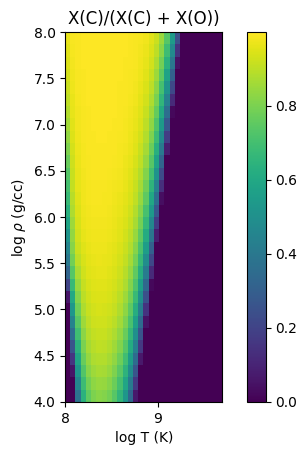Ratio of C/O from He burning#
When burning He, the relative amount of C vs. O produced from \({}^4\mathrm{He}(\alpha\alpha,\gamma){}^{12}\mathrm{C}(\alpha,\gamma){}^{16}\mathrm{O}\) is strongly dependent on the thermodynamic conditions. If the 3-\(\alpha\) rate is fast, then all of the He can be locked up in C before much O gets a chance to form. Here we look at the ratio of C and O as a function of density and temperature. We hold the density and temperature constant during the burn.
import pynucastro as pyna
First create a simple He burning network
rl = pyna.ReacLibLibrary()
lib = rl.linking_nuclei(["he4", "c12", "o16"], with_reverse=False)
net = pyna.PythonNetwork(libraries=[lib])
net.write_network("heburn.py")
import heburn
import numpy as np
from scipy.integrate import solve_ivp
Define the initial composition (molar fraction) as pure He
X0 = np.zeros(heburn.nnuc)
X0[heburn.jhe4] = 1.0
Y0 = X0 / heburn.A
We’ll use SciPy solve_ivp to do the integration, using the BDF solver.
We’ll also pass in a screening function so we evaluate with screened rates.
We can use an event to set the stop time – we will stop when \(X({}^{4}\mathrm{He}) < 10^{-7}\)
from pynucastro.screening import screen5
def he_exhaustion(t, y, rho, T, screening_fun=None):
return y[heburn.jhe4] - 1.e-7
he_exhaustion.terminal = True
he_exhaustion.direction = -1
Here’s our function that will take \((\rho, T)\) and integrate until we trigger the event, and then return \(X({}^{12}\mathrm{C})/(X({}^{12}\mathrm{C}) + X({}^{16}\mathrm{O}))\)
def doit(rho, T):
# set a really long stop time -- most runs will end before this
# because of the event trigger
tmax = 1.e35
sol = solve_ivp(heburn.rhs, [0, tmax], Y0, method="BDF", jac=heburn.jacobian,
events=he_exhaustion,
dense_output=True, args=(rho, T, screen5), rtol=1.e-6, atol=1.e-8)
XC = sol.y[heburn.jc12, -1]
XO = sol.y[heburn.jo16, -1]
return XC / (XC + XO)
Setup a grid of temperature and density
nT = 30
nrho = 30
rhomin = 1.e4
rhomax = 1.e8
Tmin = 1.e8
Tmax = 5.e9
rhos = np.logspace(np.log10(rhomin), np.log10(rhomax), nrho)
Ts = np.logspace(np.log10(Tmin), np.log10(Tmax), nT)
ratio = np.zeros((nT, nrho))
Loop over the \((\rho, T)\) pairs and store the result in the ratio() array.
for i, T in enumerate(Ts):
for j, rho in enumerate(rhos):
ratio[i, j] = doit(rho, T)
import matplotlib.pyplot as plt
fig = plt.figure()
ax = fig.add_subplot(111)
im = ax.imshow(ratio.T, origin="lower",
extent=[np.log10(Tmin), np.log10(Tmax),
np.log10(rhomin), np.log10(rhomax)])
fig.colorbar(im, ax=ax)
ax.set_xlabel("log T (K)")
ax.set_ylabel(r"log $\rho$ (g/cc)")
ax.set_title("X(C)/(X(C) + X(O))")
Text(0.5, 1.0, 'X(C)/(X(C) + X(O))')

